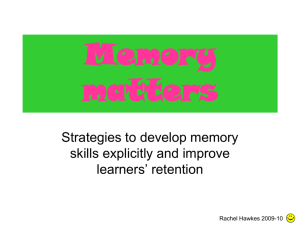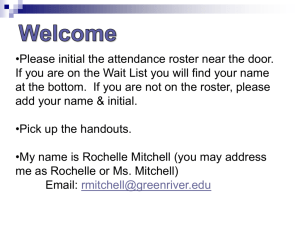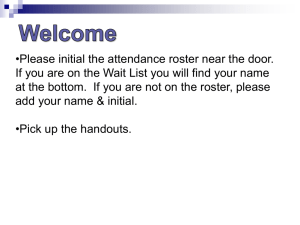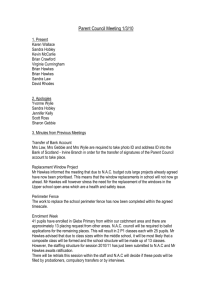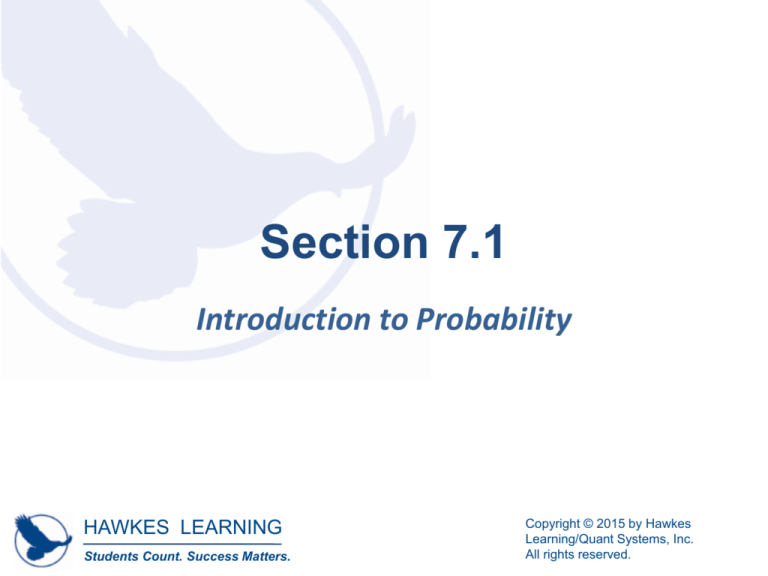
Section 7.1
Introduction to Probability
HAWKES LEARNING
Students Count. Success Matters.
Copyright © 2015 by Hawkes
Learning/Quant Systems, Inc.
All rights reserved.
Objective
o Calculate basic probabilities
HAWKES LEARNING
Students Count. Success Matters.
Copyright © 2015 by Hawkes
Learning/Quant Systems, Inc.
All rights reserved.
Introduction to Probability
To begin our discussion of probability, we need to
define a few terms. First, a trial, or probability
experiment, is any process that produces a random
result, such drawing a number from one to ten out of a
hat.
This example easily illustrates the possible individual
results, called outcomes. For this example, all numbers
from one to ten are outcomes.
HAWKES LEARNING
Students Count. Success Matters.
Copyright © 2015 by Hawkes
Learning/Quant Systems, Inc.
All rights reserved.
Introduction to Probability
The set of all possible outcomes is called the sample
space for that experiment. For the example of drawing
a number from one to ten out of a hat, the sample
space is
{1, 2, 3, 4, 5, 6, 7, 8, 9, 10}.
HAWKES LEARNING
Students Count. Success Matters.
Copyright © 2015 by Hawkes
Learning/Quant Systems, Inc.
All rights reserved.
Example 1: Determining Sample Spaces
Identify the sample space for each of the following
experiments. Note that the outcomes in a sample space
are listed between brackets and separated by commas.
a. Rolling a single die.
b. Birth order gender for two children in a single family.
HAWKES LEARNING
Students Count. Success Matters.
Copyright © 2015 by Hawkes
Learning/Quant Systems, Inc.
All rights reserved.
Example 1: Determining Sample Spaces (cont.)
Solution
a. The sample space consists of all of the possible
outcomes of rolling a die. It can land on any of the six
sides of the die. Therefore, the sample space is the
following.
b. The sample space consists of all possible gender
outcomes for a family with two children. Let B = boy
and G = girl. The sample space is
{BB, BG, GB, GG}.
HAWKES LEARNING
Students Count. Success Matters.
Copyright © 2015 by Hawkes
Learning/Quant Systems, Inc.
All rights reserved.
Skill Check #1
Skill Check #1
Identify the sample space for tossing two coins
together. You can list it inside { } separating the
elements by commas.
Answer: {HH, HT, TT, TH}
HAWKES LEARNING
Students Count. Success Matters.
Copyright © 2015 by Hawkes
Learning/Quant Systems, Inc.
All rights reserved.
Trial
Trial
A trial, or probability experiment, is any process that
produces a random result.
HAWKES LEARNING
Students Count. Success Matters.
Copyright © 2015 by Hawkes
Learning/Quant Systems, Inc.
All rights reserved.
Outcome
Outcome
The outcomes of a trial are the possible individual
results.
HAWKES LEARNING
Students Count. Success Matters.
Copyright © 2015 by Hawkes
Learning/Quant Systems, Inc.
All rights reserved.
Sample Space
Sample Space
The sample space S of a trial is the set of all possible
outcomes.
HAWKES LEARNING
Students Count. Success Matters.
Copyright © 2015 by Hawkes
Learning/Quant Systems, Inc.
All rights reserved.
Event
Event
An event E is a group, or subset, of outcomes in the
sample space.
HAWKES LEARNING
Students Count. Success Matters.
Copyright © 2015 by Hawkes
Learning/Quant Systems, Inc.
All rights reserved.
Classical Probability
Classical Probability
If all outcomes are equally likely, classical probability is
calculated with the formula
the number of possible outcomes in the event
P event
.
the number of outcomes in the sample space
P(event) will always be a real number between 0 and 1,
inclusive.
HAWKES LEARNING
Students Count. Success Matters.
Copyright © 2015 by Hawkes
Learning/Quant Systems, Inc.
All rights reserved.
Example 2: Calculating Classical Probability
Suppose you were asked to draw a card from a
standard deck of 52 cards. A standard deck of cards
contains the following cards.
HAWKES LEARNING
Students Count. Success Matters.
Copyright © 2015 by Hawkes
Learning/Quant Systems, Inc.
All rights reserved.
Example 2: Calculating Classical Probability
(cont.)
HAWKES LEARNING
Students Count. Success Matters.
Copyright © 2015 by Hawkes
Learning/Quant Systems, Inc.
All rights reserved.
Example 2: Calculating Classical Probability
(cont.)
a. What is the probability that the card you draw is
red?
b. What is the probability that the card you draw is a
diamond?
c. What is the probability that the card you draw is a
face card (king, queen, or jack)?
d. What is the probability of drawing a red spade?
HAWKES LEARNING
Students Count. Success Matters.
Copyright © 2015 by Hawkes
Learning/Quant Systems, Inc.
All rights reserved.
Example 2: Calculating Classical Probability
(cont.)
Solution
a. Because this is a standard deck of cards we are
drawing from, each card has the same probability of
being chosen. We know that the sample space
contains 52 cards. We also know that since there are
two red suits (and two black suits) each with 13
cards, there are 26 possible red cards to choose. So,
the probability that the card you draw is red is
number of red cards
26 1
P red card
0.5.
total number of cards in deck 52 2
HAWKES LEARNING
Students Count. Success Matters.
Copyright © 2015 by Hawkes
Learning/Quant Systems, Inc.
All rights reserved.
Example 2: Calculating Classical Probability
(cont.)
b. There are 13 cards in the diamond suit. So the
probability that your card is a diamond is
13 1
P diamond 0.25.
52 4
c. Each of the four suits contains three face cards (king,
queen, and jack), so there are 4 3 12 face cards to
choose from. So the probability that your card is a
face card is
12 3
P face card
0.230769.
52 13
HAWKES LEARNING
Students Count. Success Matters.
Copyright © 2015 by Hawkes
Learning/Quant Systems, Inc.
All rights reserved.
Example 2: Calculating Classical Probability
(cont.)
d. Because all spades are black, it is impossible to draw
a red spade. Therefore,
P (red spade) = 0.
HAWKES LEARNING
Students Count. Success Matters.
Copyright © 2015 by Hawkes
Learning/Quant Systems, Inc.
All rights reserved.
Example 3: Calculating Classical Probability
Suppose that you grab a snack from a bag of chocolates
that contains 4 caramel with milk chocolate, 4
peppermint with white chocolate, 6 dark chocolate
with mint, and 2 raspberry with dark chocolate. What is
the probability that you randomly grab a raspberry with
dark chocolate for your snack?
Solution
Remember, to find the probability, we first need to
know the number of outcomes in the sample space.
HAWKES LEARNING
Students Count. Success Matters.
Copyright © 2015 by Hawkes
Learning/Quant Systems, Inc.
All rights reserved.
Example 3: Calculating Classical Probability
(cont.)
We can add together all of the chocolates in the bag to
find out the number of possible outcomes.
4 + 4 + 6 + 2 = 16 different chocolates in the bag
Next, we know that there are 2 possible outcomes for
the event of choosing a raspberry with dark chocolate.
Therefore, the probability of the event is
2 1
P raspberry with dark chocolate
0.125.
16 8
HAWKES LEARNING
Students Count. Success Matters.
Copyright © 2015 by Hawkes
Learning/Quant Systems, Inc.
All rights reserved.
Empirical Probability
Empirical Probability
If all outcomes are based on an experiment, empirical
probability is calculated with the formula
the number of times the event occurs
P event
.
total number of times the experiment is performed
P(event) will always be a real number between 0 and 1,
inclusive.
HAWKES LEARNING
Students Count. Success Matters.
Copyright © 2015 by Hawkes
Learning/Quant Systems, Inc.
All rights reserved.
Example 4: Empirical Probability with Multiple
Trials
For her elementary school science fair project, Libby is
conducting research on the accuracy of the weather
prediction from her local news channel. She recorded
the forecast and the actual weather for two weeks. The
following table shows her results.
HAWKES LEARNING
Students Count. Success Matters.
Copyright © 2015 by Hawkes
Learning/Quant Systems, Inc.
All rights reserved.
Example 4: Empirical Probability with Multiple
Trials (cont.)
Table 1: Accuracy of Weather Prediction
Forecast
Rain
Chance of snow
Snow
Cloudy
Cloudy
Rain
Clear
Clear
Cloudy
Chance of snow
Clear
Clear
Rain
Chance of rain
HAWKES LEARNING
Students Count. Success Matters.
Actual Weather
Rain
Rain
Snow
Clear
Cloudy
Rain
Drizzling rain
Clear
Clear
Cloudy
Clear
Clear
Rain
Cloudy
Copyright © 2015 by Hawkes
Learning/Quant Systems, Inc.
All rights reserved.
Example 4: Empirical Probability with Multiple
Trials (cont.)
Using empirical probability, what is the probability that
the news channel accurately predicts the next day’s
weather?
Solution
For Libby to calculate the probability, she needs to
count the number of days the weatherman correctly
predicted the weather and divide it by 14 (the total
number of days she did the experiment).
HAWKES LEARNING
Students Count. Success Matters.
Copyright © 2015 by Hawkes
Learning/Quant Systems, Inc.
All rights reserved.
Example 4: Empirical Probability with Multiple
Trials (cont.)
number of times the forecast was correct
P correct prediction
total number of times the weather was recorded
8 4
0.571429.
14 7
Because Libby can now estimate that the news channel
correctly predicts the weather 57% of the time, she
knows that this is also the probability that the
prediction for the following day’s weather will be
correct.
HAWKES LEARNING
Students Count. Success Matters.
Copyright © 2015 by Hawkes
Learning/Quant Systems, Inc.
All rights reserved.
Example 5: Classical vs. Empirical Probability
Determine if the scenarios given are examples of
classical or empirical probability techniques.
a. Katie is curious about her chances of winning an
e-reader from the student government association.
She polled her friends to find out how many of them
filled out the survey to be entered in the contest.
b. Tristan is interested in his chances of winning at the
black jack table. He determines the probability of
what his next card will be by knowing the cards that
have already been played.
HAWKES LEARNING
Students Count. Success Matters.
Copyright © 2015 by Hawkes
Learning/Quant Systems, Inc.
All rights reserved.
Example 5: Classical vs. Empirical Probability
(cont.)
c. Based on the recent United States Census, the local
government estimates the amount of growth the
community will experience in the coming years.
Solution
a. Because Katie is conducting an informal survey and
not all students are included, the probability is
empirical.
HAWKES LEARNING
Students Count. Success Matters.
Copyright © 2015 by Hawkes
Learning/Quant Systems, Inc.
All rights reserved.
Example 5: Classical vs. Empirical Probability
(cont.)
b. This is an example of classical probability since all
cards have an equal chance of being dealt at the
beginning, and Tristan adjusts his chances by
accounting for those cards that have already been
drawn.
c. Since the United States Census is actually an
incomplete count, any probability calculated from it
would be empirical.
HAWKES LEARNING
Students Count. Success Matters.
Copyright © 2015 by Hawkes
Learning/Quant Systems, Inc.
All rights reserved.

